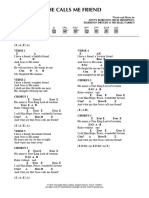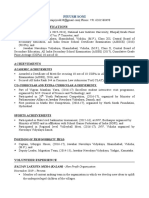0 ratings0% found this document useful (0 votes)
15 viewsFile_Handling_Python
File handling in Python enables reading, writing, updating, and deleting files, allowing for permanent data storage. Various modes such as 'r', 'w', 'a', and 'x' dictate how files are accessed and modified. The document provides examples for creating, reading, writing, appending, and deleting files, along with best practices like using the 'with' statement for automatic file closure.
Uploaded by
Chandu AlaganiCopyright
© © All Rights Reserved
We take content rights seriously. If you suspect this is your content, claim it here.
Available Formats
Download as PDF, TXT or read online on Scribd
0 ratings0% found this document useful (0 votes)
15 viewsFile_Handling_Python
File handling in Python enables reading, writing, updating, and deleting files, allowing for permanent data storage. Various modes such as 'r', 'w', 'a', and 'x' dictate how files are accessed and modified. The document provides examples for creating, reading, writing, appending, and deleting files, along with best practices like using the 'with' statement for automatic file closure.
Uploaded by
Chandu AlaganiCopyright
© © All Rights Reserved
We take content rights seriously. If you suspect this is your content, claim it here.
Available Formats
Download as PDF, TXT or read online on Scribd
You are on page 1/ 4
File Handling in Python (For Beginners)
What is File Handling?
File handling in Python allows you to read, write, update, and delete files.
It helps store data permanently, even after the program stops running.
Modes in File Handling:
--------------------------------------
'r' -> Read mode (file must exist)
'w' -> Write mode (overwrites the file, creates if not exists)
'a' -> Append mode (adds content, creates if not exists)
'x' -> Create mode (fails if file exists)
'r+' -> Read and write (file must exist)
'w+' -> Write and read (overwrites file, creates if not exists)
Examples:
1. Creating a File
-----------------------
file = open("example.txt", "w")
file.write("Hello, this is a new file!")
file.close()
2. Reading a File
-----------------------
file = open("example.txt", "r")
content = file.read()
print(content)
file.close()
3. Writing to a File (Overwrites Content)
-----------------------
file = open("example.txt", "w")
file.write("This will overwrite previous content.")
file.close()
4. Appending to a File
-----------------------
file = open("example.txt", "a")
file.write("\nAdding new content without deleting old data.")
file.close()
5. Reading Line by Line
-----------------------
file = open("example.txt", "r")
for line in file:
print(line)
file.close()
6. Using 'with' Statement (Auto Closes File)
-----------------------
with open("example.txt", "r") as file:
content = file.read()
print(content)
7. Checking If File Exists (Before Opening)
-----------------------
import os
if os.path.exists("example.txt"):
file = open("example.txt", "r")
print(file.read())
file.close()
else:
print("File does not exist.")
8. Deleting a File
-----------------------
import os
if os.path.exists("example.txt"):
os.remove("example.txt")
print("File deleted successfully.")
else:
print("File not found.")
9. Creating a File Only if It Doesn't Exist ('x' Mode)
-----------------------
try:
file = open("newfile.txt", "x")
file.write("This file is created.")
file.close()
except FileExistsError:
print("File already exists.")
10. Read and Write ('r+' Mode)
-----------------------
file = open("example.txt", "r+")
print("Before writing:", file.read())
file.seek(0)
file.write("Updated content!")
file.close()
11. Write and Read ('w+' Mode)
-----------------------
file = open("example.txt", "w+")
file.write("New data written!")
file.seek(0)
print("After writing:", file.read())
file.close()
Conclusion:
- Use 'r' to read, 'w' to write (overwrite), 'a' to append.
- 'r+' allows reading and writing (file must exist).
- 'w+' allows writing and reading (overwrites file).
- Always close files or use 'with open(...)'.
- Use 'os' module to check and delete files.
You might also like
- Class 12 COMPUTER SCIENCE PPT Chapter 2 File-Handling-In-PythonNo ratings yetClass 12 COMPUTER SCIENCE PPT Chapter 2 File-Handling-In-Python60 pages
- Python Prog Unit-4 Notes by Kamal Kant TripathiNo ratings yetPython Prog Unit-4 Notes by Kamal Kant Tripathi19 pages
- Neeraj Kumar (2201920100191) Python PptNo ratings yetNeeraj Kumar (2201920100191) Python Ppt12 pages
- Unit III File Handling and Exception HandlingNo ratings yetUnit III File Handling and Exception Handling16 pages
- Unit Vi - File Io Handling and Exception HandlingNo ratings yetUnit Vi - File Io Handling and Exception Handling52 pages
- CBSE Class 10 Maths Chapter 8 Introduction to Trignometry Objective QuestionsNo ratings yetCBSE Class 10 Maths Chapter 8 Introduction to Trignometry Objective Questions13 pages
- LAB211 Assignment: Title Background Program SpecificationsNo ratings yetLAB211 Assignment: Title Background Program Specifications3 pages
- COS20007 Portfolio Format and Assessment CriteriaNo ratings yetCOS20007 Portfolio Format and Assessment Criteria8 pages
- Advanced Topics in Fuzzy Graph Theory John N. Mordeson - Download the ebook today and own the complete content100% (1)Advanced Topics in Fuzzy Graph Theory John N. Mordeson - Download the ebook today and own the complete content70 pages
- Your Child Is Between 8 and 12 Years Old and Is Learning French?No ratings yetYour Child Is Between 8 and 12 Years Old and Is Learning French?2 pages
- Crafting Literary Texts With Proper StructureNo ratings yetCrafting Literary Texts With Proper Structure2 pages
- Submitt Ed By: Student ID: Subject: ECE2551No ratings yetSubmitt Ed By: Student ID: Subject: ECE25519 pages
- Continuous Integration: Improving Software Quality and Reducing RiskNo ratings yetContinuous Integration: Improving Software Quality and Reducing Risk40 pages
- De Guzman Lea Marie b Bse e Rog 2023 2024 1stNo ratings yetDe Guzman Lea Marie b Bse e Rog 2023 2024 1st1 page
- UNIT 1 Android Developer Fundamentals (V2) PDF100% (1)UNIT 1 Android Developer Fundamentals (V2) PDF310 pages
- VAASTE LYRICS - Dhvani Bhanushali Feat. Nikhil D'SouzaNo ratings yetVAASTE LYRICS - Dhvani Bhanushali Feat. Nikhil D'Souza6 pages

























































































